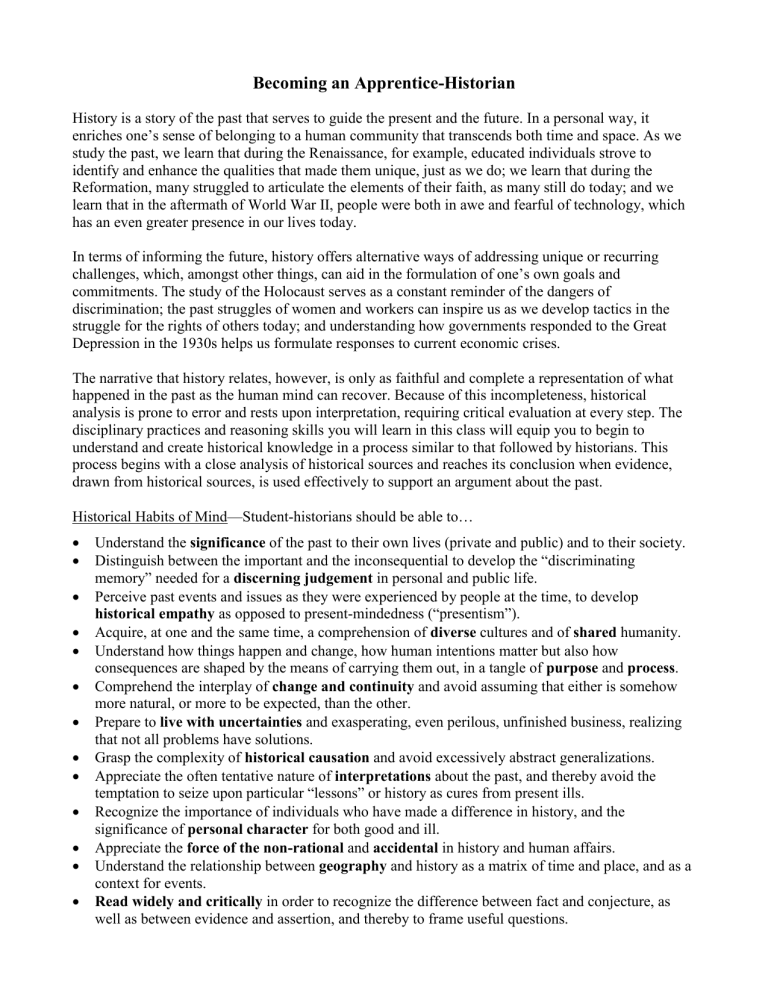
Becoming an Apprentice-Historian History is a story of the past that serves to guide the present and the future. In a personal way, it enriches one’s sense of belonging to a human community that transcends both time and space. As we study the past, we learn that during the Renaissance, for example, educated individuals strove to identify and enhance the qualities that made them unique, just as we do; we learn that during the Reformation, many struggled to articulate the elements of their faith, as many still do today; and we learn that in the aftermath of World War II, people were both in awe and fearful of technology, which has an even greater presence in our lives today. In terms of informing the future, history offers alternative ways of addressing unique or recurring challenges, which, amongst other things, can aid in the formulation of one’s own goals and commitments. The study of the Holocaust serves as a constant reminder of the dangers of discrimination; the past struggles of women and workers can inspire us as we develop tactics in the struggle for the rights of others today; and understanding how governments responded to the Great Depression in the 1930s helps us formulate responses to current economic crises. The narrative that history relates, however, is only as faithful and complete a representation of what happened in the past as the human mind can recover. Because of this incompleteness, historical analysis is prone to error and rests upon interpretation, requiring critical evaluation at every step. The disciplinary practices and reasoning skills you will learn in this class will equip you to begin to understand and create historical knowledge in a process similar to that followed by historians. This process begins with a close analysis of historical sources and reaches its conclusion when evidence, drawn from historical sources, is used effectively to support an argument about the past. Historical Habits of Mind—Student-historians should be able to… Understand the significance of the past to their own lives (private and public) and to their society. Distinguish between the important and the inconsequential to develop the “discriminating memory” needed for a discerning judgement in personal and public life. Perceive past events and issues as they were experienced by people at the time, to develop historical empathy as opposed to present-mindedness (“presentism”). Acquire, at one and the same time, a comprehension of diverse cultures and of shared humanity. Understand how things happen and change, how human intentions matter but also how consequences are shaped by the means of carrying them out, in a tangle of purpose and process. Comprehend the interplay of change and continuity and avoid assuming that either is somehow more natural, or more to be expected, than the other. Prepare to live with uncertainties and exasperating, even perilous, unfinished business, realizing that not all problems have solutions. Grasp the complexity of historical causation and avoid excessively abstract generalizations. Appreciate the often tentative nature of interpretations about the past, and thereby avoid the temptation to seize upon particular “lessons” or history as cures from present ills. Recognize the importance of individuals who have made a difference in history, and the significance of personal character for both good and ill. Appreciate the force of the non-rational and accidental in history and human affairs. Understand the relationship between geography and history as a matrix of time and place, and as a context for events. Read widely and critically in order to recognize the difference between fact and conjecture, as well as between evidence and assertion, and thereby to frame useful questions. Analyzing Historical Sources and Evidence You best develop the ability to reason historically by exploring and interpreting a wide variety of primary and secondary sources, and not merely regurgitating content from a textbook or your notes. Primary sources provide evidence of the past that may point to some larger aspect of a historical development or process. Secondary sources provide you with practice in analyzing how historical arguments are developed using diverse historical evidence. Additionally, exposure to a variety of diverse historical interpretations builds your ability to evaluate the effectiveness of different types of historical arguments and apply them to your life and the world today. In order to do their work, historians must be active readers—able to comprehend what they have read and use the information in meaningful ways to build an understanding of the past. Similarly, you must develop the skills necessary to be an active reader who can extract useful information from texts, make supportable inferences, and draw appropriate conclusions from the sources. The analysis of a primary source requires more than a mere description or summary of its content. When a historian analyzes a source, he or she thinks critically not only about the content of the source, but also who the author and presumed audience of the source were, why the source was produced, and what factors influenced the production of that source. All of these factors contribute to the usefulness of the source for a historian in answering particular historical questions. In analyzing primary sources, therefore, several different features need to be considered, including its content, authorship, author’s point of view, author’s purpose, audience, format, and historical context. Analyzing these features helps establish the reliability of the source and its possible limitations for historians. A rigorous analysis of sources focuses on the interplay between all of these features of a source, enabling one to effectively evaluate its usefulness in answering a particular historical question. Content What point(s) is the document trying to make? What does the document not say (i.e., does it selectively include and/or exclude information)? What of its content is usable by a historian? Format/ medium What is the format of the source: text, image, art, newspaper article, letter, cartoon, lyrics, oped, etc? What does the choice of medium reveal about the author’s intent? Does the source’s format or genre (novel, romantic poetry, Impressionist painting, cartoon) add meaning to what the source explicitly states? Authorship Author’s point of view Author’s purpose Who wrote the document and what is his or her relationship to the historical event being addressed? What was the author’s position in society? Do we know anything about this person beyond what is provided in the source that would affect the reliability of the document? What was the author’s point of view? Does the author’s point of view undermine the explicit purpose of the source? How can you tell, if at all, what other beliefs the author might hold? Why did the author create the source? Why was the document created at this time? Why has it survived to the present? How does its purpose affect its reliability or usefulness? Historical situation When and where was the source produced? What contemporaneous events might have affected the author’s viewpoint and/or message? How does the historical situation that the source was produced in affect the reliability of a source? Audience Who was the source created for? How might the audience have affected the content of the source? How might the audience have affected the reliability of the source? Limitations What does the document not tell me? What might have limited the knowledge of the author (e.g., social status or position, education)? What other kinds of sources might fill in the content gaps? What other documents might offer alternatives to the author’s point of view? What other documents might help to better understand the author’s own point of view? Using Historical Reasoning to Develop Effective Historical Arguments When they study the past, historians inquire into the reasons why historical events, processes, and actions unfolded the way they did. As they begin to articulate possible explanations of these events, historians use reasoning processes that rely on their awareness of different types of causal relationships, connections, and patterns. They then formulate a claim, or thesis, about why the event or process occurred the way it did, and then develop an argument that explains how the claim is supported by the available historical evidence. A strong historical argument also accounts for how some evidence might seem to modify or refute the claim, addressing alternate explanations of the event or process. In order for students to learn how to create persuasive and meaningful historical arguments, AP history teachers should help students improve their proficiency with each of these practices in turn. Students can develop their ability to reason meaningfully about the past by using the same skills and practices they encounter in historical writings. The most common ways in which historians reason about the past involve: seeing the connections between the particular and the general (contextualization) analyzing similarities and differences (comparison) analyzing cause and effect (causation) identifying long-term patterns of continuity or change over time Historians employ these types of reasoning to construct explanations about the causes and significance of past events, using evidence to support their claims. Historians also must take disparate and sometimes contradictory evidence into account in making their arguments, considering possible alternative explanations and the underlying complexity of the processes they examine. Contextualization What was happening at the time the event occurred or the document was created that might have had an influence? What was happening at the specific place where an event occurred? In the country as a whole? In the larger region? In the world? How does a specific event relate to larger processes? How do larger processes shape a specific event? How does the context in which a source is read or viewed inform how it is understood? Comparison Causation Continuity and change over time How is one development like/unlike another development from the same time/a different time? Why did an event or development affect different groups in different ways? How does a viewpoint (from a historical actor or historian) compare with another when discussing the same event or historical development? What were the reasons for this event? What factors contributed to a specific pattern or trend? What prompted this person/group to act/react this way? What resulted from this event, pattern, or action? What were the short-term effects? What were the long-term effects? What cause seemed to be the most significant? What effect seemed to be the most significant and why? How do the assessments of historians concerning causation differ from those who experienced the event, pattern, or action? How might the chain of cause and effect have changed and at what point? What causes were contingent on previous effects? What individual choice(s) made a significant difference in the lead up to a particular event or trend? Was there a moment of chance that influenced the chain of events? What has changed within a specific time period? What has remained the same within a specific time period? What can explain why some things have changed and others have not? How are continuity and change represented in different types of sources; for example, in graphs, charts, political cartoons, and texts? What might be the reasons behind different depictions of continuity and change?






